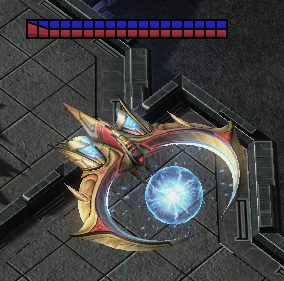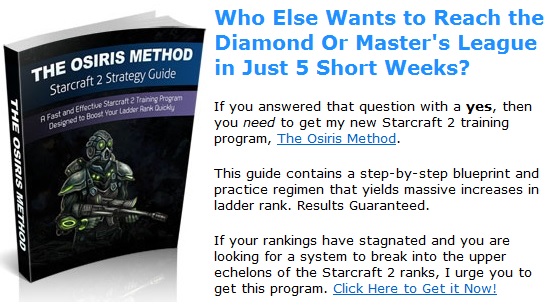Starcraft 2 Tempest Info, Abilities, & GameplayStarcraft 2 Strategy Guide --> Heart of the Swarm Guide --> New HotS Units --> Tempest (you are here)
This unit also possess the Protoss's best anti-massive-air capabilities, a former weak point for the Protoss. It also has the distinction of being a one of the units that newbie players love to mass. Tempest ProductionCost: 300 minerals, 200 vespene gas, 4 supplies. Production Time: 60 seconds. Produced at: Stargate Requirements: Fleet Beacon Class: Armored - Mechanical - Massive
Tempest Stats & InfoHealth: 150 shields, 300 health. Kinetic Overload: Anti-air attack. Deals 30 damage (+3 per upgrade point) to regular air units and deals 85 damage (+5 per upgrade point) to massive air units. The Tempest uses this attack on Colossi as well. Resonance Coil: Anti-ground attack. Deals 30 damage (+3 per upgrade point) to all ground units. Attack Speed: 3.3 (very slow). Both Tempest attacks use this attack speed. Range: 15 (incredibly far). Both Tempest attacks use this attack range. Movement Speed: 1.88 (slow). Armor: 2 Do not let the damage values of the Tempest fool you: its damage is actually quite low due to its very slow attack speed. The real value of the Tempest is that it has a very long range (15), allowing the Protoss to actually siege turtling enemies. It also has very generous shield, health, and armor totals for a 4 supply unit. SC2 Tempest Gameplay VideoThe Tempest is a unit you should see in action to appreciate just how much range it has. The Tempest can attack units beyond its vision, and its attack range is marked by the small white areas that appear in-game when you highlight the unit: Starcraft 2 Tempest StrategiesThe Tempest is one of the most popular units in Starcraft 2's Heart of the Swarm expansion. Players love to use this ship because it is quite strong for its supply cost and because it looks really cool. The first thing you must understand about the Tempest is that it has a very high resource cost. A Tempest only takes up 4 supplies, but costs a whopping 300 minerals and 200 vespene gas. By comparison, 4 supplies worth of Zealots is just 200 minerals (and no gas) and 4 supplies of Stalkers are 250 minerals and 100 gas - both significantly less than the cost of a Tempest. As a result, it is hard to incorporate Tempests successfully into your army unless the opponent is using massive air units (massive air units are very weak against the Tempest) or unless you are benefiting from a 1+ expansion lead over your opponent. If you do not have this income lead, it is going to be much more cost-effective to go with a ground-based army. The second thing you must realize is that the Tempest does not do that much damage (except against massive air units). While its individual attack does a lot of damage (30 damage base, 39 with +3 weapons), it has to wait 3.3 game seconds between attacks. It also has an overkill problem when used in large numbers. By comparison, a Siege Tank in Siege Mode has an attack speed of 3 seconds, and deals 35 damage to light (44 with +3 upgrades), 50 to armored (65 with +3 upgrades), and deals splash damage. Not only does it do more damage, but it costs 3 supplies instead of 4! The Tempest has 3 primary strengths: its incredible range, its toughness, and its bonus damage to massive air units. Using the Tempest as a Siege Unit The range of 15 allows the Tempest to act as a siege unit. This means that just a few Tempest can sit over top of your primary Protoss ball and attack enemy buildings and units, provoking them to attack. Imagine you are fighting a Terran player who is walled in at their natural with Siege Tanks and Vikings offering a stalwart defense. In the past, the Protoss player would have to throw away many units in order to break this turtle or try to find an alternative attack route. This made it difficult for the Protoss player to choose a time that they wanted to attack. Now, the Protoss player can sit outside the Terran base and use their Tempest to force a Terran attack. If the Terran does not push out, the Protoss player will eventually whittle down their defenses and can move in from there. The large range of the Tempest means that it becomes more effective when used in large numbers. Think about it this way: a single Siege Tank is not much of a threat to a couple Roaches, but 25 Siege Tanks can easily take out 100 Roaches. The reason this occurs is because when you get a large number of siege units in one clump, they can take out a noticeable amount of enemy units before the enemy units are in range to actually attack. Rather than 25 Siege Tanks fighting 100 Roaches, by the time the Roaches are in range, it is really more like 25 Siege Tanks fighting 50 Roaches. The same effect occurs with the Tempest. Your Tempests will be typically able to get off two full attacks before a regular unit is in range to attack it. If you have 25 Tempests, this means 50 total Tempest attacks before the enemy even gets in range. When you consider that 3 Tempest attacks kill off a Hydralisk, this means that in a 25 Tempest vs 50 Hydralisk battle (100 supplies each), 16 Hydralisks are going to die before they even get in range to attack the Tempests! Pitting the remaining 34 Hydralisks in-range against 25 Tempests is not even a battle - the Tempests will roll over the Hydralisks without a problem, so you can see how large army sizes favor the Tempest. Note that while this looks like the Tempest is an unstoppable force on paper, it does not consider overkill. Tempests are the worst unit in the game for overkill. Overkill occurs when multiple units attack the same target beyond the target's HP pool. For example, if a Hydralisk suddenly wandered into range of 15 Tempests, all 15 Tempests would attack it, dealing 450+ worth of damage to an 80 HP unit. This is a big waste. Tempests also cost 200 vespene gas each. Getting 25 Tempests would run 5000 vespene alone, not ncluding infrastructure or upgrades. In standard play, getting a large Tempest army is not possible without taking 3+ bases. Durability of the Tempest Another feature of the Tempest is that it has a very high shields and health total for its supply. With 2 armor, 150 shields, 300 health, and only a supply cost of 4, the Tempest is a very beefy unit. In comparison, the Void Ray has the same supply cost but only has 100 shields and 150 health - barely more than half that of the Tempest! With no armor, the Tempest is twice as survivable as the Void Ray. With that said, the Tempest needs that durability as it has a very low movement speed. The Tempest should not be used to harass the enemy as it is far too slow to escape. If you are using the Tempest for harassment, include a Mothership Core in the army so you can use Mass Recall to escape. The Tempests high health, shields, and armor but low speed make it great for incorporating in your main army. They can absorb a lot of damage, so they work well in any end-game "Protoss Deathball". As an Anti-Massive/Air Unit The Tempest is undoubtedly the best Protoss unit to use against massive air units (Colossi, Carriers, Battlecruisers, Brood Lords, and other Tempests). It deals 80 damage per hit with no upgrades (95 with upgrades), and thanks to its massive range, it can severely damage massive air units before they ever reach your army. You do not need many Tempests to fill this function - 3 Tempests can shift the balance of a fight in your favor should you find yourself facing any massive air unit. You will likely always want to include a few Tempests in your army in the late-game to help deal with these massive air units, should your economy be robust enough to support the technology. Since the Tempest is pretty good in its own right, there is no harm in getting a few Tempests to fill this anti-massive air unit function. Even if the enemy does not use massive air units, Tempests are still nice to have against regular units. Note that Protoss rely heavily on Tempests or Colossus in Protoss vs Protoss, you will practically always want a few Tempests in mirror match ups. Starcraft 2 Tempest Guide ConclusionThe Tempest is a powerful Protoss flyer that can be used to back up virtually any army. It is the go-to unit for the Protoss if your enemy is using massive air units. The Tempest is extremely powerful for its supply cost, so maxing out on Tempests is a very powerful army composition. However, Tempests are very expensive, so maxing out on them is unlikely without having a significant economic advantage over your opponent. |
Don't be shy - share this page on G+ and Twitter!
Sign up for my Free Starcraft 2 Mini-Course where I reveal my best strategies not seen anywhere on this site!
Starcraft 2 Strategy Guide Privacy Policy Contact Us Disclaimer
©2013 www.osirissc2guide.com
 The Tempest is a Protoss unit introduced in Heart of the Swarm. This is a late-game
heavy flying siege unit with a relatively low damage but massive range.
The Tempest is a Protoss unit introduced in Heart of the Swarm. This is a late-game
heavy flying siege unit with a relatively low damage but massive range.
